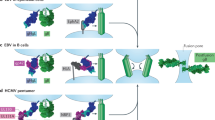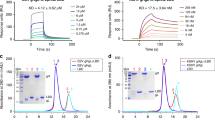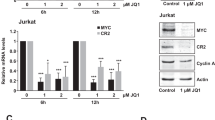Abstract
Human cytomegalovirus (HCMV) is a widespread opportunistic herpesvirus that causes severe and fatal diseases in immune-compromised individuals, including organ transplant recipients and individuals with AIDS1. It is also a leading cause of virus-associated birth defects and is associated with atherosclerosis and coronary restenosis1,2,3. HCMV initiates infection and intracellular signalling by binding to its cognate cellular receptors4,5 and by activating several signalling pathways including those mediated by mitogen-activated protein kinase5,6,7, phosphatidylinositol-3-OH kinase8, interferons5,9, and G proteins10. But a cellular receptor responsible for viral entry and HCMV-induced signalling has yet to be identified. Here we show that HCMV infects cells by interacting with epidermal growth factor receptor (EGFR) and inducing signalling. Transfecting EGFR-negative cells with an EGFR complementary DNA renders non-susceptible cells susceptible to HCMV. Ligand displacement and crosslinking analyses show that HCMV interacts with EGFR through gB, its principal envelope glycoprotein. gB preferentially binds EGFR and EGFR–ErbB3 oligomeric molecules in Chinese hamster ovary cells transfected with erbB family cDNAs. Taken together, these data indicate that EGFR is a necessary component for HCMV-triggered signalling and viral entry.
This is a preview of subscription content, access via your institution
Access options
Subscribe to this journal
Receive 51 print issues and online access
$199.00 per year
only $3.90 per issue
Buy this article
- Purchase on Springer Link
- Instant access to full article PDF
Prices may be subject to local taxes which are calculated during checkout




Similar content being viewed by others
References
Huang, E.-S. & Kowalik, T. F. in Molecular Aspects of Human Cytomegalovirus Diseases (eds Becker, Y., Darai, G. & Huang, E. S.) 1–45 (Springer, Berlin, 1993)
Melnick, J. L., Adam, E. & Debakey, M. E. Cytomegalovirus and atherosclerosis. Eur. Heart J. 14 (suppl. K), 30–38 (1993)
Speir, E. et al. Potential role of human cytomegalovirus and p53 interaction in coronary restenosis. Science 265, 391–394 (1994)
Yurochko, A. D. et al. The human cytomegalovirus UL55 (gB) and UL75 (gH) glycoprotein ligands initiate the rapid activation of Sp1 and NF-κB during infection. J. Virol. 71, 5051–5059 (1997)
Boyle, K. A., Pietropaolo, R. L. & Compton, T. Engagement of the cellular receptor for glycoprotein B of human cytomegalovirus activates the interferon-responsive pathway. Mol. Cell. Biol. 19, 3607–3613 (1999)
Johnson, R. A., Huong, S. M. & Huang, E. S. Activation of the mitogen-activated protein kinase p38 by human cytomegalovirus infection through two distinct pathways: a novel mechanism for activation of p38. J. Virol. 74, 1158–1167 (2000)
Johnson, R. A., Ma, X. L., Yurochko, A. D. & Huang, E. S. The role of MKK1/2 kinase activity in human cytomegalovirus infection. J. Gen. Virol. 82, 493–497 (2001)
Johnson, R. A., Wang, X., Ma, X. L., Huong, S. M. & Huang, E. S. Human cytomegalovirus up-regulates the phosphatidylinositol 3-kinase (PI3-K) pathway: inhibition of PI3-K activity inhibits viral replication and virus-induced signaling. J. Virol. 75, 6022–6032 (2001)
Simmen, K. A. et al. Global modulation of cellular transcription by human cytomegalovirus is initiated by viral glycoprotein B. Proc. Natl Acad. Sci. USA 98, 7140–7145 (2001)
Shibutani, T. et al. Pertussis toxin-sensitive G proteins as mediators of the signal transduction pathways activated by cytomegalovirus infection of smooth muscle cells. J. Clin. Invest. 100, 2054–2061 (1997)
Olayioye, M. A., Neve, R. M., Lane, H. A. & Hynes, N. E. The ErbB signaling network: receptor heterodimerization in development and cancer. EMBO J. 19, 3159–3167 (2000)
Earp, H. S., Dawson, T. L., Li, X. & Yu, H. Heterodimerization and functional interaction between EGF receptor family members: a new signaling paradigm with implications for breast cancer research. Breast Cancer Res. Treat. 35, 115–132 (1995)
Riese, D. J. & Stern, D. F. Specificity within the EGF family/ErbB receptor family signaling network. BioEssays 20, 41–48 (1998)
Alroy, I. & Yarden, Y. The ErbB signaling network in embryogenesis and oncogenesis: signal diversification through combinatorial ligand–receptor interactions. FEBS Lett. 410, 83–86 (1997)
Schlessinger, J. Cell signaling by receptor tyrosine kinases. Cell 103, 211–225 (2000)
Yarden, Y. & Schlessinger, J. Epidermal growth factor induces rapid, reversible aggregation of the purified epidermal growth factor receptor. Biochemistry 26, 1443–1451 (1987)
Ullrich, A. & Schlessinger, J. Signal transduction by receptors with tyrosine kinase activity. Cell 61, 203–212 (1990)
Baulida, J., Kraus, M. H., Alimandi, M., Di Fiore, P. P. & Carpenter, G. All ErbB receptors other than the epidermal growth factor receptor are endocytosis impaired. J. Biol. Chem. 271, 5251–5257 (1996)
Peles, E. & Yarden, Y. Neu and its ligands: from an oncogene to neural factors. BioEssays 15, 815–824 (1993)
Prenzel, N., Fischer, O. M., Streit, S., Hart, S. & Ullrich, A. The epidermal growth factor receptor family as a central element for cellular signal transduction and diversification. Endocr. Relat. Cancer 8, 11–31 (2001)
Tvorogov, D. & Carpenter, G. EGF-dependent association of phospholipase C-γ1 with c-Cbl. Exp. Cell Res. 277, 86–94 (2002)
Kraus, M. H., Popescu, N. C., Amsbaugh, S. C. & King, C. R. Overexpression of the EGF receptor-related proto-oncogene erbB-2 in human mammary tumor cell lines by different molecular mechanisms. EMBO J. 6, 605–610 (1987)
Tzahar, E. et al. Pathogenic poxviruses reveal viral strategies to exploit the ErbB signaling network. EMBO J. 17, 5948–5963 (1998)
Tzahar, E. et al. Bivalence of EGF-like ligands drives the ErbB signaling network. EMBO J. 16, 4938–4950 (1997)
Compton, T., Nepomuceno, R. R. & Nowlin, D. M. Human cytomegalovirus penetrates host cells by pH-independent fusion at the cell surface. Virology 191, 387–395 (1992)
Pietropaolo, R. L. & Compton, T. Direct interaction between human cytomegalovirus glycoprotein B and cellular annexin II. J. Virol. 71, 9803–9807 (1997)
Fairley, J. A., Baillie, J., Bain, M. & Sinclair, J. H. Human cytomegalovirus infection inhibits epidermal growth factor (EGF) signalling by targeting EGF receptors. J. Gen. Virol. 83, 2803–2810 (2002)
Miyazawa, N. et al. Fiber swap between adenovirus subgroups B and C alters intracellular trafficking of adenovirus gene transfer vectors. J. Virol. 73, 6056–6065 (1999)
Kanda, S. et al. Phosphatidylinositol 3′-kinase-independent p70 S6 kinase activation by fibroblast growth factor receptor-1 is important for proliferation but not differentiation of endothelial cells. J. Biol. Chem. 272, 23347–23353 (1997)
Sexl, V. et al. Stimulation of the mitogen-activated protein kinase via the A2A- adenosine receptor in primary human endothelial cells. J. Biol. Chem. 272, 5792–5799 (1997)
Acknowledgements
We thank S. Kenney, D. Y. Huang, B. Y. Huang, D. Evers, A. Gartner, A. T. Pelletier and J. S. Pagano for discussion, technical assistance and critically reading the manuscript. This work was supported by grants from the National Institutes of Health (to E.-S. H.).
Author information
Authors and Affiliations
Corresponding author
Ethics declarations
Competing interests
The authors declare that they have no competing financial interests.
Rights and permissions
About this article
Cite this article
Wang, X., Huong, SM., Chiu, M. et al. Epidermal growth factor receptor is a cellular receptor for human cytomegalovirus. Nature 424, 456–461 (2003). https://doi.org/10.1038/nature01818
Received:
Accepted:
Issue Date:
DOI: https://doi.org/10.1038/nature01818
This article is cited by
-
EGFR core fucosylation, induced by hepatitis C virus, promotes TRIM40-mediated-RIG-I ubiquitination and suppresses interferon-I antiviral defenses
Nature Communications (2024)
-
Viruses exploit growth factor mechanisms to achieve augmented pathogenicity and promote tumorigenesis
Archives of Microbiology (2024)
-
The potential of swine pseudorabies virus attenuated vaccine for oncolytic therapy against malignant tumors
Journal of Experimental & Clinical Cancer Research (2023)
-
Host Manipulation Mechanisms of SARS-CoV-2
Acta Biotheoretica (2022)
-
Modulation of host cell signaling during cytomegalovirus latency and reactivation
Virology Journal (2021)
Comments
By submitting a comment you agree to abide by our Terms and Community Guidelines. If you find something abusive or that does not comply with our terms or guidelines please flag it as inappropriate.



